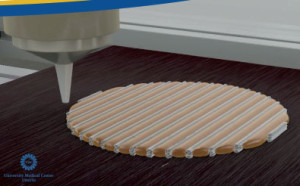Bioprinting is fascinating. We have not yet even come close to fully mastering the possibilities offered by additive manufacturing of plastic and metal components that we are already dreaming of 3D printing entire complex organs. After visiting Dr. Jos Malda and the new state-of-the-art 3D Bioprinting facility he is constructing at Utrecht University and Research Hospital, I understand that, while that will not happen anytime soon, the 3D bioprintng future is wide open and the possibilities it offers are amazing.
As Michael recently reported, Dr Malda is launching the first Masters in Bioprinting in a project spanning over two continents that is joining together the universities of Utrecht and Wuerzolfsburg in Europe with Sydney Queensland University of Technology and the University of Wollongong in Australia. That is not the only activity he is involved in — adding momentum to the blooming 3D bioprinting industry.
It all begins, especially as far as I am concerned, with the bioprinting course I recently had the opportunity to attend at Utrecht University. The course’s concept was to demonstrate the similarities and points of contact between desktop 3D printing and bioprinting. I participated on Wednesday when the discussion moved on from FDM to real bioprinting possibilities. It begins with regenerative medicines (the science of re-growing cells and organs using primarily various types of cells and stem cells) and continues with using these cellular materials – perhaps mixing them with biocompatible thermoplastics – to assemble tissue structures. This will be done in the new facility that is being built.
“It will be centralized in a new building”, Dr. Malda, who has a background in bioprocess engineering and has been setting up the university’s bioprinting activities for the past eight years, explained to me. “There will be 120 researchers completely dedicated to regenerative medicine and biofabrication. Our main work within the bioprinting facility in the early stages is on cartilage and underlying bones. For this type of biological structures, bioprinting technologies are mature and the development of bioinks is taking off exponentially. Our goal is to create a hub of knowledge focused on Utrecht while reaching out to the international scientific community.”
Bioinks are the materials used to 3D bioprint. They are used just like filament on an FDM 3D printer although they are gelatinous and contain live cells so they do not and cannot be heated past temperatures that are compatible with organic life. Just like in industrial and desktop 3D printing, materials are the key to the future of 3D bioprinting only, having to do with cells and stem cells that can transform into many different types of organic tissues, they are infinitely more complex. This means that what awaits us is a period of extreme research and constant discovery, combining new knowledge in regenerative medicine and additive, digital manufacturing.
This became apparent to me when, during the course, one student proposed a possibile experiment with a certain type of cellular material combination and Maastricht University professor Lorenzo Moroni, who is working with Dr. Malda on this project and is an expert in a Electrospinning technology, simply replied he should go ahead and test it. Right now there are literally hundreds of thousands of possibilities and the only way to find out if they could work is to try them out. A fantastic time to be (or become) a bioengineer.
That said, we have to be realistic. The complexities inherent to producing a fully functional organ such as a liver or kidneys are enormous and will not be overcome anytime soon, though I do believe they will one day. Dr Malda does also and he knows the processes and steps that will lead to that.
“Along with auricular and knee cartilaginous structures, we are working on liver stem cells and liver regeneration,” he explains. “We need to create a biological 3D model that we can use as a screening or a disease sample for that specific tissue. Once we are able to do that, if we can “mature it” correctly, we might one day be able to use it for implantation.”
“Drug screening is traditionally done on a flat surfaced petri dish but cells behave differently in a 3D environment than they do in a 3D one,” Dr. Malda continued. “That is why we use gels to create the 3D structures. In the case of skin, the cells are, to a certain extent, able to self re-organize to assume the same form as ex vivo skin. We can thus create artificial 3D skin and study its reactions to external stimuli such as burns. In the case of a liver it is a lot more difficult as the different hepatic, endothelial and muscle cells do not self re-organize. We need to be able to 3D print them in the right places while also creating the internal vascular structure.”


The “knowledge sharing” aspect will be implemented through the International Conference, Biofabrication 2015, that has just been announced and will be held in Utrecht on November 7-9 of next year. The multi-disciplinary meeting, co-chaired by Dr. Malda and Professor Moroni, will gather research leaders, scholars, clinicians and industry representative from around the world to exchange ideas and provide “out of the box” insights from all fields related to biofabrication.
In a field moving as fast as that of bioprinting, who knows what they will be talking about 18 months from now. I, for one, cannot wait to find out.




